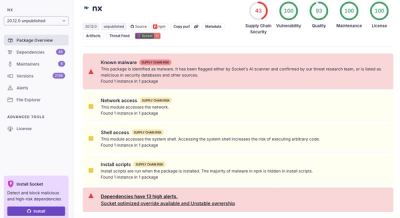
Security News
Nx npm Packages Compromised in Supply Chain Attack Weaponizing AI CLI Tools
Malicious Nx npm versions stole secrets and wallet info using AI CLI tools; Socket’s AI scanner detected the supply chain attack and flagged the malware.
newrelic_plugins_hive
Advanced tools
Without this gem, if you're using more then one plugin for NewRelic you need to download each plugin, configure it in different files and repositories, deploy it separately and run different process for each plugin (including monitor those processes etc...) NewRelic Plugins Hive allow you to easily download, configure and deploy multiple NewRelic plugins and run them all in one process!
Install the gem:
$ gem install newrelic_plugins_hive
Create a new hive application (this will create a new folder with the name you specified and the default folder structure and files):
$ hive new <APP_NAME>
First, you need to configure which New Relic plugins you want to use in the hive.
To do that open the file config/newrelic_hive.yml and add for each plugin its github repository and a path to the agent file in the repository.
Example structure of the file:
plugins:
sidekiq:
github: https://github.com/eksoverzero/newrelic_sidekiq_agent
agent_path: newrelic_sidekiq_agent
rabbitmq:
github: https://github.com/gopivotal/newrelic_pivotal_agent
agent_path: plugins/pivotal_rabbitmq_plugin/pivotal_rabbitmq_plugin.rb
redis:
github: https://github.com/gopivotal/newrelic_pivotal_agent
agent_path: plugins/pivotal_redis_plugin/pivotal_redis_plugin.rb
It is enough that agent_path attribute will specify a unique filname in the repository. So in the example above you can just use this agent_path for redis:
agent_path: pivotal_redis_plugin.rb
This will download and extract the plugin agents that specified in config/newrelic_hive.yml:
$ hive install
Configuring the plugins in the hive requires 3 simple steps:
config/newrelic_plugin.ymlconfig/newrelic_plugin.yml under the section agentsExample: The RabbitMQ plugin has a configuration to specify the rabbitmq url, as well as the Sidekiq plugins that requires the Redis uri, so example config/newrelic_plugin.yml will look like:
newrelic:
license_key: 'YOUR_LICENSE_KEY_HERE'
# Set to '1' for verbose output, remove for normal output.
verbose: 1
agents:
rabbitmq:
management_api_url: http://user:password@hostname:55672
sidekiq_status_agent:
-
instance_name: "Name"
uri: "redis://localhost:6379"
namespace: "namespace"
This example combine in the same config/newrelic_plugin.yml configurations from two different plugins (rabbitMQ and Sidekiq).
You must look at your plugin documentation and follow the instructions how to configure it.
Run the agent:
$ hive run
Or, as a maemon:
$ hive run -d start # Start the daemon
$ hive run -d stop # Stop the daemon
git checkout -b my-new-feature)git commit -am 'Added some feature')git push origin my-new-feature)FAQs
Unknown package
We found that newrelic_plugins_hive demonstrated a not healthy version release cadence and project activity because the last version was released a year ago. It has 1 open source maintainer collaborating on the project.
Did you know?

Socket for GitHub automatically highlights issues in each pull request and monitors the health of all your open source dependencies. Discover the contents of your packages and block harmful activity before you install or update your dependencies.

Security News
Malicious Nx npm versions stole secrets and wallet info using AI CLI tools; Socket’s AI scanner detected the supply chain attack and flagged the malware.

Security News
CISA’s 2025 draft SBOM guidance adds new fields like hashes, licenses, and tool metadata to make software inventories more actionable.

Security News
A clarification on our recent research investigating 60 malicious Ruby gems.